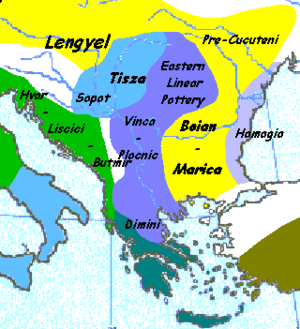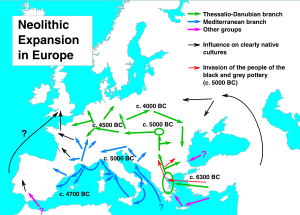Neolithic Greece
 | |
| Period | Neolithic Europe |
|---|---|
| Dates | c. 7000 – c. 3200 BC |
| Major sites | Nea Nikomedeia, Sesklo, Dimini, Franchthi Cave, Athens |
| Preceded by | Balkan Mesolithic, Pre-Pottery Neolithic B |
| Followed by | Sesklo culture, Cycladic culture, Minoan civilization, Helladic period, Cardium Pottery, Starčevo culture |
Part of a series on the |
|---|
| History of Greece |
 |
|
History by topic |
|
|
Neolithic Greece is an archaeological term used to refer to the Neolithic phase of Greek history beginning with the spread of farming to Greece in 7000–6500 BC. During this period, many developments occurred such as the establishment and expansion of a mixed farming and stock-rearing economy, architectural innovations (i.e. "megaron-type" and "Tsangli-type" houses), as well as elaborate art and tool manufacturing.
Periodization
The Neolithic Revolution reached Europe beginning in 7000–6500 BC when agriculturalists from the Near East entered the Greek peninsula from Anatolia mainly by island-hopping through the Aegean Sea.[1] Modern archaeologists have divided the Neolithic period of Greek history into six phases: Pre-Pottery, Early Neolithic, Middle Neolithic, Late Neolithic I, Late Neolithic II and Final Neolithic (or Chalcolithic).
| Period | Approximate Date |
|---|---|
| Pre-Pottery (or Aceramic) | 6800–6500 BC[2] |
| Early Neolithic | 6500–5800 BC[3] |
| Middle Neolithic | 5800–5300 BC[4] |
| Late Neolithic I | 5300–4800 BC[5] |
| Late Neolithic II | 4800–4500 BC[6] |
| Final Neolithic (or Chalcolithic) | 4500–3200 BC[7] |
Settlements of Neolithic Greece
These are the estimated populations of hamlets, villages, and towns of Neolithic Greece over time. Note that there are several problems with estimating the sizes of individual settlements, and the highest estimates for a given settlements, in a given period, may be several times the lowest.
| Town | 7000 BC | 6000 BC | 5000 BC | 4000 BC | 3800 BC | 3700 BC |
|---|---|---|---|---|---|---|
| Nea Nikomedeia | 500–700[8] | |||||
| Sesklo | 1,000–5000[9] | |||||
| Dimini | ||||||
| Franchthi Cave | ||||||
| Athens | ||||||
Pre-Ceramic
The Pre-Ceramic (or Aceramic) period of Neolithic Greece is characterized by the absence of baked clay pots and an economy based on farming and stock-rearing.[2] Settlements consisted of subterranean huts partially dug into the ground with communities inhabited by 50 to 100 people in places such as Argissa (Thessaly), Dendra (Argolid) and Franchthi.[2] The inhabitants cultivated various crops (i.e. einkorn, emmer wheat, barley, lentils and peas), engaged in fishing, hunting, animal husbandry (i.e. raising cattle, pigs, sheep, dogs and goats), developed tools (i.e. blades made from flint and obsidian) and produced jewellery from clay, seashells, bone and stone.[2]
Early Neolithic (EN)
The Pre-Ceramic period of Neolithic Greece was succeeded by the Early Neolithic period (or EN) where the economy was still based on farming and stock-rearing and settlements still consisted of independent one-room huts with each community inhabited by 50 to 100 people (the basic social unit was the clan or extended family).[3] Hearths and ovens were constructed in open spaces between the huts and were commonly used.[3] During the Early Neolithic period, pottery technology involving the successful firing of vases was developed and burial customs consisted of inhumation in rudimentary pits, cremation of the dead, bone collection, and cemetery interment.[3]
Middle Neolithic (MN)
The Middle Neolithic period (or MN) is characterized by new architectural developments such as houses constructed with stone foundations and the development of megaron-type dwellings (rectangular one-roomed houses with open or closed porches).[4] Furthermore, the "Tsangli-type" house, named after the settlement of Tsangli, was first developed during the Middle Neolithic period; the "Tsangli-type" dwelling has two interior buttresses on each side (designed to support the roof of the house and divide the dwelling space into separate rooms for distinct functions such as storage, food preparation and sleep quarters) with a row of posts in the center of the square room.[4] In the realm of art, the meander-labyrinth motif was found on seals and jewellery of the Early Neolithic period and, to a lesser extent, of the Middle Neolithic period.[4] The Middle Neolithic period ended with the devastation of certain settlements by fire; communities such as Sesklo were abandoned whereas communities such as Tsangli-Larisa were immediately re-inhabited.[4]
Late Neolithic (LN)
Late Neolithic I (LNI)
The Late Neolithic I period (or LNI) is characterized by settlement expansion and the intensification of the farming economy where shrubs and wooded areas were cleared in order to secure grazing fields and arable lands.[5] During this period, new crops were cultivated such as bread wheat, rye, millet and oat (food was prepared in hearths and ovens usually found inside houses).[5] Animals such as sheep and goats were raised for their wool, which was used to weave garments.[5] Communities were inhabited by 100–300 individuals socially organized into nuclear families and settlements consisted of large megaron-type rectangular structures with timber-post frames and stone foundations.[5] Many settlements were surrounded by ditches 1.5–3.5 meters deep and 4–6 meters wide, which were constructed probably to defend against wild animals and to protect goods by establishing the borders of the settlements themselves.[5]
Late Neolithic II (LNII)
The Late Neolithic I period was succeeded by the Late Neolithic II period (or LNII) where economic and social life in existing settlements continued uninterruptedly.[6]
Final Neolithic (FN)
The Final Neolithic (or Chalcolithic) period entails the transition from the Neolithic farming and stock-rearing economy to the metal-based economy of the Early Bronze Age.[7] This transition occurred gradually when Greece's agricultural population began to import bronze and copper and used basic bronze-working techniques first developed in Asia Minor with which they had cultural contacts.[10]
Population
According to Gareth Alun Owens, the Neolithic period saw the development of Minoan and Greek as distinct Indo-European languages in Crete and mainland Greece respectively.[11] In archaeogenetic studies, Greco-Armenian speakers diverged from the Proto-Indo-European language family around 5300–5000 BC coinciding with the Neolithic spread of agriculture from Asia Minor to Greece with Greek developing into a separate language before 4000 BC.[12]
Gallery
 Map of the world showing approximate centers of origin of agriculture and its spread in prehistory.[13]
Map of the world showing approximate centers of origin of agriculture and its spread in prehistory.[13] A map showing the Neolithic expansions from the 7th to the 5th millennium BCE, including the Cardium Culture in blue.
A map showing the Neolithic expansions from the 7th to the 5th millennium BCE, including the Cardium Culture in blue.
See also
References
Citations
- ↑ Pashou, Drineas & Yannaki 2014, p. 5: "The earliest Neolithic sites with developed agricultural economies in Europe dated 8500–9000 BPE are found in Greece. The general features of material culture of the Greek Neolithic and the genetic features of the preserved crops and associated weeds of the earliest Greek Neolithic sites point to Near Eastern origins. How these Near Eastern migrants reached Greece is a matter of speculation...Our data support the Anatolian rather than the Levantine route because they consistently show the Aegean islands to be connected to the Near East through Anatolia. Archaeological evidence from Greek and Near Eastern and Anatolian Neolithic sites suggests that multiple waves of Neolithic migrants reached Greece and Southern Europe. Most likely multiple routes were used in these migrations but, as our data show, the maritime route and island hopping was prominent."
- 1 2 3 4 "Neolithic Period in Greece: Pre-Ceramic Neolithic". Athens: Foundation of the Hellenic World. 1999–2000.
- 1 2 3 4 "Neolithic Period in Greece: Early Neolithic". Athens: Foundation of the Hellenic World. 1999–2000.
- 1 2 3 4 5 "Neolithic Period in Greece: Middle Neolithic". Athens: Foundation of the Hellenic World. 1999–2000.
- 1 2 3 4 5 6 "Neolithic Period in Greece: Late Neolithic I". Athens: Foundation of the Hellenic World. 1999–2000.
- 1 2 "Neolithic Period in Greece: Late Neolithic II". Athens: Foundation of the Hellenic World. 1999–2000.
- 1 2 "Neolithic Period in Greece: Final Neolithic or Chalcolithic". Athens: Foundation of the Hellenic World. 1999–2000.
- ↑ Milisauskas 2011, p. 182.
- ↑ Runnels & Murray 2001, p. 146: "Theocharis believed that the entire area from there to the upper acropolis of the site was filled with habitations and that Sesklo was a town of perhaps 5,000 people, rather than a village. Other archaeologists working at the site have reduced the population estimate to between 1,000 and 2,000, but either way, Sesklo was a settlement of impressive size in its day."
- ↑ Pullen 2008, p. 20; van Andels & Runnels 1988, "The transition to the Early Bronze Age", pp. 238–240; French 1973, p. 53.
- ↑ Owens 2007, p. 5: "Η ελληνική γλώσσα εξελίχθηκε από μια διάλεκτο της πρώτο-ινδοευρωπαϊκής οικογένειας σε μια ξεχωριστή γλώσσα κατά τη Νεολιθική Περίοδο, και μάλλον μια τέτοια διεργασία σημειώθηκε στον ελλαδικό χώρο...Οι ρίζες της μινωικής γλώσσας ανιχνεύονται στη γλώσσα των νεολιθικών κατοίκων της Κρήτης, οι οποίοι έφεραν μια διάλεκτο της πρώτο-ινδοευρωπαϊκής οικογένειας περίπου στα 8–7.000 π.Χ.."
- ↑ Gray & Atkinson 2003, pp. 437–438; Atkinson & Gray 2006, p. 102.
- ↑ Diamond & Bellwood 2003, pp. 597–603. The world map depicts agricultural centers in the Fertile Crescent (11,000 BP), the Yangtze and Yellow River basins (9,000 BP) and the New Guinea Highlands (9,000–6,000 BP), Central Mexico (5,000–4,000 BP), Northern South America (5,000–4,000 BP), sub-Saharan Africa (5,000–4,000 BP, exact location unknown), and eastern North America (4,000–3,000 BP).
Sources
- Atkinson, Quentin D.; Gray, Russel D. (2006). "Chapter 8: How Old is the Indo-European Language Family? Illumination or More Moths to the Flame?". In Forster, Peter; Renfrew, Colin. Phylogenetic Methods and the Prehistory of Languages. Cambridge: McDonald Institute for Archaeological Research. pp. 91–109. ISBN 978-1-902937-33-5.
- Diamond, Jared; Bellwood, Peter (2003). "Farmers and Their Languages: The First Expansions". Science. 300 (5619): 597–603. doi:10.1126/science.1078208. PMID 12714734.
- Gray, Russel D.; Atkinson, Quentin D. (2003). "Language-tree Divergence Times Support the Anatolian Theory of Indo-European Origin". Nature. 426: 435–439. doi:10.1038/nature02029. PMID 14647380.
- Milisauskas, Sarunas (2011). "Chapter 7: Early Neolithic, the First Farmers in Europe, 7000–5500/5000 BC". In Milisauskas, Sarunas. European Prehistory: A Survey (2nd ed.). New York: Springer Science and Business Media, LLC. pp. 153–222. ISBN 978-1-44-196633-9.
- Runnels, Curtis Neil; Murray, Priscilla (2001). Greece Before History: An Archaeological Companion and Guide. Stanford, CA: Stanford University Press. ISBN 978-0-80-474050-0.
- Owens, Gareth Alun (2007). "Η Δομή της Μινωικής Γλώσσας ["The Structure of the Minoan Language"]" (PDF) (in Greek). Heraklion: TEI of Crete –Daidalika.
- Pashou, Peristera; Drineas, Petros; Yannaki, Evangelia (2014). "Maritime Route of Colonization of Europe" (PDF). Proceedings of the National Academy of Sciences of the United States of America. 111 (25): 9211–9216. doi:10.1073/pnas.1320811111.
- Pullen, Daniel (2008). "The Early Bronze Age in Greece". In Shelmerdine, Cynthia W. The Cambridge Companion to the Aegean Bronze Age. Cambridge and New York: Cambridge University Press. pp. 19–46. ISBN 978-0-521-81444-7.
